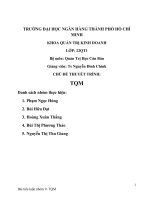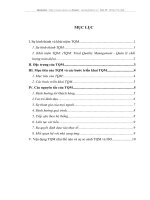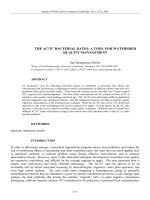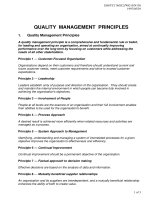Quality management assignment 2
Bạn đang xem bản rút gọn của tài liệu. Xem và tải ngay bản đầy đủ của tài liệu tại đây (281.09 KB, 14 trang )
Contents
1. Introduction
Enterprises are born for the purpose of profit, which is the highest goal. In addition, a goal is
no less important and lasting development. Whether the purpose is to maximize profits by
reducing costs, increasing efficiency of the use of resources and developing policies to attract
and develop human resources in order to create competitive advantage is the important business
need to do to achieve this goal. A quality management system is the best tool helps enterprises
continuous improvement and archives their targets. In this BTEC semester, we research Quality
Management Subject and apply it for Mozilla Foundation. This report includes: identifying key
performance to measure the quality and analyzing statistical process control to improve the
quality by 4 main schemes is: Total Quality Management (TQM), Lean, Six Sigma and ISO
standard.
2. Examine the concept of quality management in a business and services
context
(1a) Define quality in terms of businesses and services provision
There are many ways to define what quality means. When a company creates products or
services they need many processes to perform this. And the quality of each process influence
on the final products of services. The important thing of a company is making more and more
profits and customers are the candidate who decides how much benefit a company receives.
The customer decides to buy a product or using a services depend on their qualities. Therefore
“quality” must be defined by customer. In simply way we can understand “quality” as “doing
the right thing right the first time, always striving for improvement, and always satisfying the
customer” (QM, BPP Professional Education, 2004).
In term of business, a company can evaluate quality by the customer’ satisfaction. There
are many factors involve to evaluation such as: customer’s expectation, perceived quality,
perceived value, complaint and loyalty.
Complaint
Expectations
Perceived
Perceived quality
value
SI
Loyalty
(American Customer Satisfaction Index – ACSI)
In fact, when customer’s expectation is high, the perceived quality is high too. Therefore
the quality of products and services provide for customer must be ensure the customer
satisfaction. When perceived value and perceived quality is higher than customer’s
expectation, it can make the loyalty of customer. In the other hand, there is complaint if these
value and quality do not reach the customer’s satisfaction. In case study, Mozilla is a developsoftware company and their customer paid for using Mozilla’s software. This company has
many strategies to measure and improve the quality to meet customer’s demand. For example:
when develop a new version of Firefox (a software that was used for website browsers), they
doing many tests to control every processes of updating software and take feedback from their
customer to complete the improvement of this product.
In business, the company needs to measure their product/service’s qualities to ensure they
are satisfying the customer’s demand. There are several of measurements the company can
use. The variation is a factor of quality’s measurement. The main purpose in business is
making more profit and less variation the company has, it means more profit they can get. The
company have to identify the quality of each version for each products while make enough
variation to attract the customer. Moreover, the company can measure the quality by the KPI’s
(Key Performance Indicators) and using Statistical process control (SPC) “Using objective
measurements over subjective feelings to continually improve processes in order to improve
quality and eliminated waste” (QM, BPP Professional Education, 2004).
Key Indicators for Physical Products
•
Reliability
•
Aesthetics
•
Adaptability
•
Usability
•
Functionality
•
Appropriateness
Key Indicators for Services
•
Friendliness/courteousness of employees
•
Safety/risk of service
•
Billing/invoicing procedure
•
Responsiveness to requests
•
Appearance of physical facilities
•
Approachability of the service provider
•
Willingness to listen to customer
•
Honesty and an ability to communicate in clear language
(Wordpress.com, n.d.)
This is clearly that the way how customers see and measure quality is different with the
company see and measure quality. While the company use figure about turnovers, profit and
the number of customer and take analysis to measure the quality, customers do it simpler.
Customer can access the quality of a product during the process of using: the product is
durable enough, this product is good design or not, the product price is cheap or expensive, is
it deserve for the money they paid.
(1b) Define quality in terms of customer satisfaction
For customer, quality was defined in terms of their overall experience with the company.
During a period of time to use a product or service from the company, the customer takes the
experience and has decisions to continue use this product/service or not.
The customer can see the quality of product or services by many factors. If they use a
product they focus on design, durable, price, using value and advantage competition of this
product with other firm’s product. In case study, Mozilla release Firefox software and it take
competition with two strong competitors like Internet Explorer (default browser in Microsoft
Windows) and Chrome (from Google Corporation).If the customer uses a service, they focus
on trust, communication, availability, office environment and employee’s attitude toward
customer. A popular measuring scheme quality was use in 1990s is SERVQUAL was
developed by Zeithaml, Parasuraman & Berry. In general follow them who created this model,
the quality of service was determined by 5 factors including: the tangible, reliability, ability to
react, assurance and empathy.
The customer measures the quality of product or services by measure these factors above.
If they satisfy them, it means the quality of the product/ service is good enough and deserves to
pay. The company and the customer have different in see quality of a product or a service. The
company depends on the customer feedback about their satisfaction and take improve process.
The QA (Quality Assurance) process was performed appropriately by Mozilla when they want
to release new version of Firefox. They have many tests to control the process, improve them
and release follow business plan. They have writing test case which reused in the following
versions of the product to save time and salvage the old features but good. They also maintain
test cases to keep track of those tests and find the defect of the new version. All processes need
the volunteer from customer to use and feedback. And then they fix it and improve.
(1c) Explain how the organization should measure its quality management
Both the customer and the manager interested in quality. Corporate culture focuses on quality
because quality speaks the value of the company. So they are indispensable tools which measure
quality because the new company's products want to have quality must be controlled by these
tools. However, currently quality control tools based on data analysis is divided into two groups:
i.
Group 1: Includes seven traditional tools, also known as seven quality control tools (7 QC
tools). They have also known as ISHIKAWAS 7QC tools which revolutionized the Japanese
& the World in Sixties & Seventies (www.isixsigma.com, n.d.). The basis of these tools is
the theory of statistics. The tools include:
• Check sheet: This is the first step in the process based on data analysis. Data obtained
from the test instrument is input to the other data analysis tools.
• Pareto chart: use of columns to illustrate the phenomena and causes, grouped as types of
defects, reproduce, repair, complaints, accidents and breakdowns. The straight line
segments are added to indicate the cumulative probabilities.
• Cause-effect diagram: only the relationship between objective characteristics and other
factors, these factors seem to affect the characteristics, represented by drawings like fish
bones.
• Histogram: is a type of bar chart in which the volatile elements or specific data are
divided into classes or into sections and expressed as the column is expressed with the
distance class market through the bottom and the frequency indicated by the height.
• Statistical Process Control Charts: is a graph of straight line segments represents the
average value of the properties, the rate of disability or disabilities. They are used to
check for abnormalities of the process based on the change of the properties.
• Scatter diagram: dispersion diagram shows the relationship between two variables in
numerical analysis. To solve the problem and determine the optimal conditions by
quantitative analysis of cause and effect relationship between the variables.
• Stratified diagram: The partition common to find the cause of the disability.
ii. Group 2: These tools are very effective support for the analysis to find the cause of poor
quality as well as find solutions to improve quality (Tague, 2004).
• Affinity diagram: Analysis of the problem based on the feeling
• Relation diagram: Analysis based on logic problems
• Matrix diagram: Detection of the relationship between objectives and strategies, the
proposed solution and the ability to perform
• Prioritization Matrix: Find out priorities for the proposed solution.
• Tree diagram: split a goal into smaller goals or a plan into detailed plans can be
implemented in practice. This chart can also be used to analyze the causes similar causal
diagram.
• Arrow diagram: Used to determine the facts, the causes of the problem to increase the
•
effective planning solution
Process Decision Program Chart (PDPC): Tools to plan and predict random uncertainty
by combining information at all stages of the process.
Chart of a week in the lives of Firefox users (Smith, 2011)
Mozilla has excellent performance even when there are contests for their products to the
users; they even brought the topic of quality management as the topic for the competition. The
winner is who used Statistical Process Control Charts tool to assess the quality of Firefox users
in a week for ages. Mozilla publics information of product with customer, it not only help people
understand company; also make them feeling about Firefox as a friendly product. With Statistical
Process Control Charts, Mozilla Firefox can know the interest of customer groups in each time
period in the day and week. Since then the group will have developed strategies to attract and
improve the product to entice customers remaining participants using the same product in that
period Investigate four different quality management schemes appropriate to commercial
operations. When Mozilla have data collection from Statistical Process Control Charts, supplier’s
group will have planned to attract more people using Firefox at the same time. Such as, they
supply more flash game, sale off Mozilla’s product to attract young people use Firefox on
Thursday.
(2a) Describe the rationale underpinning four quality schemes commonly
adopted by commercial operations
Quality management is an important sector of developing a company. There are many ways
to managing quality; the company wants to increase the quality of product/services. In this
report, there are 4 common schemes which were recommended to managing quality for manager.
They are Total Quality Management (TQM), Lean, Six Sigma and ISO 9000. Then I talk about
them and their benefit of company.
Total Quality Management (TQM): TQM is a system of managing quality depends on the
attendance of all members in an organization, always increase the customer’s satisfaction with
improve quality, find out solution to avoid defect and eliminate overlapping.
Lean is an improvement approach to improve flow and eliminate waste. Lean is basically
about getting the right things to the right place, at the right time, in the right quantities, while
minimizing waste and being flexible and open to change. (institute.nhs.uk, n.d.)
Six Sigma is a method of rigorous and science conducting, focusing on the implementation
of effective techniques and principles of quality management has been recognized. By
combining elements of many different areas of work, 6 Sigma focuses on how to do the job
without error or defect.
(hotrodoanhnghiep.gov.vn, n.d.)
ISO 9000 is a series of standards, developed and published by the International Organization
for Standardization (ISO), that define, establish, and maintain an effective quality assurance
system for manufacturing and service industries. (techtarget.com, n.d.)
Commonly noted benefits of Lean are Improving productivity, quality and flexibility.
Likewise, the commonly noted benefits of Six Sigma are customer satisfaction and improving
operational efficiency. TQM benefits are improving customer satisfaction and producing better
product quality. Commonly observed benefits of ISO are better documentation, Quality
awareness and help to take more market advantage. Finally from a critic's standpoint, statistical
analysis is not valued in Lean. Six sigma approaches and the DMAIC principle work well only if
the variations are normal. TQM focuses on long term results instead of short term results. Of
late, organizations give high priority to the projects which yield results within a short span of
time. Financial improvements of implementing ISO were not proved well and it is the biggest
criticism of using ISO to improve the quality of products and services.
Besides the standard of product and service‘s quality changes day by day. Because the
customer more demanding when choosing a product or service. Besides that the number of
competitors is increasing that make the market shares divided to many small parts and the
existence company must share the total market shares. Therefore the good quality makes the
advantage competition of a company to deal with these problems. By using 4 common schemes:
Lean, Six Sigma, TQM and ISO 9000 make the manager control the process of product
manufacturing or providing services with improve the quality of each product. When the process
is improved, the quality of final product also increases. It can attract more customers. They can
see and measure the quality of product/ services and decide to use. It means the sales of product
also increase and the company makes more profits. It shows the main purpose of using 4
schemes to managing quality.
(2b)Identify the main similarities and differences between four quality management systems
Similarities
There are four similarities between TQM, Lean, Six
Sigma and ISO 9000
Firstly, all schemes principle is “focus on customers”.
All of them support the manager control process in
manufacturing product or providing services to meet the
customers’ satisfaction. In details:
TQM: focus on reducing product defects, by improving
your manufacturing process, and therefore customers are
happier (businessknowledgesource.com, n.d.)
Lean: Lean Manufacturing Guide: "flowing the product
at the demand of the customer" (ehow.com, n.d.)
Six Sigma: Understanding what customers really care
about is fundamental to Six Sigma, because our
processes have to perform at a measurable level that
consistently
meets
the
customer’s
needs.
(improvementandinnovation.com, n.d.)
ISO 9000: the ISO 9001 requirement is inclined towards
the underlying concept of customer responsiveness,
which is defined as giving customers what they have
contracted to receive. (isorequirements.com, n.d.)
In general, we recognized that all quality schemes
concentrate on how to satisfy the customer. Because if
the customers are satisfied, the company will gets more
profit and invests to improve the quality. Customer
becomes the main subject with many quality schemes.
Secondly, continuous improvement is the second
similarity principle among the four schemes. All process
has existed problem and always need to improve step by
step. If the quality schemes were applied without
continuous improvement, the company cannot develop
the business. Continuous improvement increases the rate
of successful with applying the quality schemes.
Thirdly, leadership from the top is similar among 4
schemes. All requirements from manager will be
transfer to employees to complete their own work. It is
Differences
TQM
Lean
ISO 9000
Six-sigma
TQM focuses on
using SPC to reduce
the variation while
Therefore, the cost
production
was
reduced and the
period of making
product can meet the
rate of progress.
Statistical
Process
Control (SPC) is a
technique used within
the TQM framework
for reducing variation
in
processes
(qualityamerica.com,
n.d.). TQM was
invented well. The
focus of TQM is
general improvement
using collaborative
and cultural approach
to a proble. TQM
emphasizes increased
performance levels;
(Differentbetween.co
m, n.d.)
Lean differs from other
improvement methods
in several ways, but
two of the differences
are
particularly
noteworthy. First, lean
focuses on improving
entire value streams,
while most of the other
improvement methods
tend to focus on
individual processes. In
lean terminology, a
"value stream" is all of
the activities that a
company must perform
in order to produce and
deliver a product or
service to a customer.
So, a value stream is
really a system that is
composed of numerous
individual
processes.
Lean organizations do
work on improving
individual
processes,
but lean practitioners
always remember that
the real goal is to
improve the whole
value creation/delivery
system
and
that
improving one process
won't
necessary
ISO 9000 focuses on
process
management
through the use of
rigorous
international
manufacturing
benchmarks
and
requirements. ISO 9000
defines the most basic
processes an organization
must have in place to
control quality, and builds
on that.
ISO uses a methodology
system, known as the ISO
Quality
Management
System. It consists of
systematic
methods,
documented
processes
and
identified
responsibilities.
The
company must have a
quality-control
system
that explains how it meets
the requirements for each
process within a given
standard or benchmark.
The
policies
and
procedures must be welldocumented
and
the
company must abide by
them. The company must
maintain good statistical
records on quality. It must
also be regularly audited
Six Sigma is a
business
management
strategy that strives
to
improve
the
quality of process
outputs. It identifies
and
eliminates
causes of errors and
reduces variability in
business processes
and manufacturing.
Six Sigma uses two
methodologies,
known as DMAIC
and DMADV. Six
Sigma
DMAIC
focuses on defining,
measuring,
analyzing,
improving
and
controlling existing
processes,
within
Six
Sigma
specifications. Six
Sigma DMADV, on
the other hand,
concentrates
on
defining, measuring,
necessary if the manager use any quality schemes.
Leadership from top helps all stages work perfectly in a
united process and avoid the misunderstanding among
sectors in an organization’s system.
Finally similarity among these schemes is focus on
quality. Quality effect to the profit the company can take
therefore every scheme focus on this to find the solution
to improve. TQM, Six Sigma, ISO and Lean can support
the company improve their quality. The quality is the
main principle with every scheme and they need focus
on this.
improve
performance
value
the
of the
stream.
Another
important
difference is that most
process improvement
methods tend to focus
on
improving
the
productivity
or
efficiency of major
value-adding processes,
while lean emphasizes
reducing or eliminating
non-value-adding
activities (waste). When
a lean practitioner looks
at an activity or
process, he/she will ask
a series of questions:
Does
this
activity/process
add
value for a customer? If
not, can we change the
way we work to
eliminate the need for
the activity/process? If
not, can we change the
activity/process so that
it will consume less
resources.
In order for a company to
adhere to ISO 9000
standards, it must be
certified. An outside
assessor examines the
company. The assessor
questions
the
staff,
confirming that each
member knows his or her
role in complying with
these standards. The
assessor also scrutinizes
the
company’s
documentation, verifying
that it complies with set
standards. The assessor
then produces a report,
identifying any areas in
which the company has
not met the standards. The
company has a period of
time to resolve these
issues. After the problems
are corrected, the assessor
will make the company
ISO 9000-certified.
analyzing,
designing,
and
verifying
new
processes
or
products so that they
may meet Six Sigma
standards.
Six Sigma, on the
other hand, has
several certifications
a company can
obtain,
including
Black
Belt
and
Green Belt. A Black
Belt
certification
focuses on team
leadership, such as
allocating roles and
responsibilities
to
team members. A
Green
Belt
certification focuses
only
on
the
company's ability to
analyze and solve
quality problems.
(2c) Explain the importance of communication and record keeping in quality
schemes
Communication is a process that helps manager and control the distribution of work for each
employee in the company when they communicate and discuss together. When manager
communicate with employees, staffs will feel that they are respected. This will be easier to run
the company. In addition staffs also give conditions for their ideas about work. When employees
talk to each other they will be able to help each done a better way.
Record keeping is the storing of information that has been systematically and carefully
collected and stored for intended use. To run any economic enterprise successfully, carefully
thought out, properly collected and kept records are a must for the purpose of keeping track and
decision making (dictionary.reference.com, n.d.). Record keeping can help the manager to:
•
•
Prepare your financial statements
Identify source of receipts
(irs.gov, n.d.)
Financial statements is one of the record keeping, it is the best way which help company
control finance and profit of Mozilla. Based on data collection, manager will find out profit and
loss account of their company each month, quarter and year. They also know the expense that
they help to pay each month through income statement. Moreover, according to the balance sheet
the manager of Mozilla knows the liability and asset they own.
The determination of the origin receipts will help the company to thoroughly manage money
or property. From there they can calculate the exact profit. There is also help the company does
not have any problems with the law.
If the company do not has a good keeping record or the manager and employees do not have
a good communication it will lead to the lack of information about the company situation and
also lead to the misunderstand about working so that the employees can still finish their work
less well.
3. Conclusion
This helps the company improve the quality of Mozilla services. Increased competition with
rivals and optimized management system. From that strategic planning is the development
company for 10 and 20 years.
4. References
'BPP Professional Education'.
dictionary.reference.com, [Online], Available: />[2012].
Henning, J. (2009) vovici.com, 24 Mar, [Online], Available: [2012].
irs.gov, [Online], Available: [2012].
isixsigma.com, [Online], Available: [2012].
iso.org, [Online], Available: [2012].
Kotler, P. (2011) arpitsrivastava.wordpress.com, [Online], Available:
/>[2012].
lean.org, [Online], Available: [2012].
sixsigmatraining.org, [Online], Available: [2012].
Smith, D. (2011) r-bloggers.com, [Online], Available: [2012].
Tague, N.R. (2004) asq.org, [Online], Available: [2012].
www.isixsigma.com, [Online], Available: [2012].
www.six-sigma-material.com, [Online], Available: [2012].









